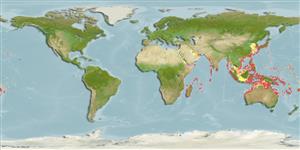Classification / Names
Common names from other countries
Main reference
Size / Weight / Age
Max length : 320 cm TL male/unsexed; (Ref. 247); common length : 250 cm TL male/unsexed; (Ref. )
Length at first maturity
Lm ?, range 230 - ? cm
Environment
Marine; reef-associated; depth range 0 - 70 m (Ref. 106604), usually 5 - 30 m (Ref. 43278)
Climate / Range
Tropical, preferred ?; 41°N - 27°S, 32°E - 169°W
Distribution
Indo-Pacific: Persian Gulf (Ref.80050), Red Sea and East Africa to the Tuamoto Islands, north to southern Japan, south to Australia.
Countries | FAO areas | Ecosystems | Occurrences | Introductions
Short description
Dorsal
spines
(total): 0;
Dorsal
soft rays
(total): 0;
Anal
spines: 0;
Anal
soft rays: 0. A large, bulky nurse shark with a small mouth and small comb-like teeth, and with angular fins (Ref. 5578). Caudal fin shorter, much less than half the length of body; no ridges on side of the body; pectoral fins falcate (Ref. 6871). Brown dorsally, paler ventrally (Ref. 391); fins slightly dusky (Ref. 9999). Spiracles much smaller than eye (Ref. 9999).
IUCN Red List Status (Ref. 115185)
Human uses
Fisheries: commercial; gamefish: yes
More information
ReferencesAquacultureAquaculture profileStrainsGeneticsAllele frequenciesHeritabilityDiseasesProcessingMass conversion
Tools
Special reports
Download XML
Internet sources
Estimates of some properties based on models
Phylogenetic diversity index
PD50 = 1.0625 many relatives (e.g. carps) 0.5 - 2.0 few relatives (e.g. lungfishes)
Trophic Level
4.1 ±0.4 se; Based on diet studies.
Resilience
Very Low, minimum population doubling time more than 14 years (Fec=4)
Vulnerability
Very high vulnerability (77 of 100)
Price category
